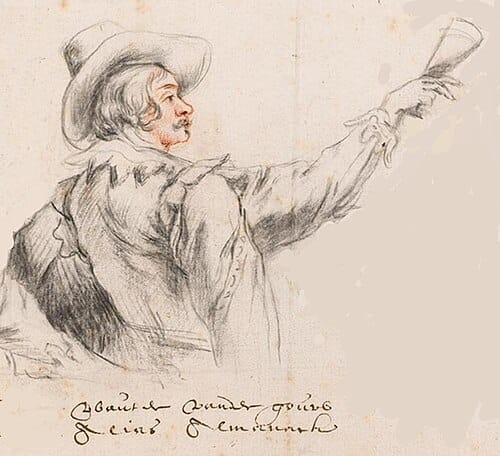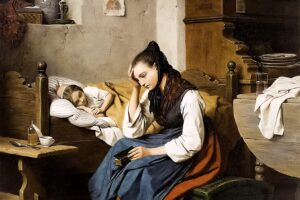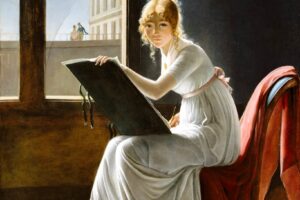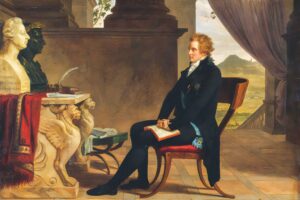Officers and Guardsmen of the Company of Colonel Herman Herbertsz
Wouter Crabeth II, 1644 – Baroque
Painted in 1644 by Dutch artist Wouter Crabeth II, this grand group portrait belongs to the Baroque tradition of civic pride and collective identity. Commissioned during the Dutch Golden Age, it honors the officers and guardsmen of the civic militia—ordinary men given a heroic dignity through oil, canvas, and a painter’s steady eye. It is not a scene of war, but one of readiness, dignity, and fellowship. Together, they form not just a regiment, but a portrait of unity.
The Scene Before Us
Seventeen men stand in formal assembly, resplendent in black doublets trimmed with white lace and silken sashes of red, white, and blue. Some hold staffs of office; others rest a hand on a sword. Two red flags mark the edges of the composition, framing the group in a visual gesture of command and allegiance. Their stances vary—some confront the viewer directly, others turn in casual rapport. We are not in battle, but in peacetime ritual. Their presence is ceremonious, their expressions composed, their purpose clear.
The Deeper Meaning
In the 17th-century Dutch Republic, militia groups were defenders of cities and symbols of civic order. Paintings like this were public affirmations of community, hierarchy, and shared responsibility. The varied sashes and poses distinguish rank and role, but there is no sense of separation—these men are presented as equals in duty. This is a portrait of citizen-soldiers, not conquerors. Crabeth captures not action, but readiness, the silent discipline of men who may never draw swords, yet remain pledged to protect.
A Moment Caught in Time
The shadows are soft, the background architectural, but it is the men who anchor the image. Their clothing may speak of wealth and position, but their faces carry stories—some youthful and fresh, others weathered and stern. Each expression is distinct. It is as if we’ve arrived moments before a march or just after an inspection. They are paused, mid-life, mid-service, captured in a collective stillness that stretches beyond the frame. A century later, their names may be forgotten, but their stance remains.
About Artist

Wouter Pietersz. Crabeth II (c. 1594 – 1644) was a Dutch Golden Age painter who, through his travels, became a prominent figure in the dissemination of Baroque style in the Netherlands. He was the most important artist of his time in his hometown of Gouda.
Italian Influence and Caravaggism
Crabeth’s artistic journey was profoundly shaped by his “Grand Tour” of Italy, a customary rite of passage for artists of his era. While in Rome, he became a member of the Bentvueghels, a society of Dutch and Flemish artists. During this period, he was heavily influenced by the work of Caravaggio and his followers, known as the Caravaggisti. This influence is evident in his masterful use of tenebrism, a technique characterized by dramatic, high-contrast lighting that creates a spotlight effect on the figures, pulling them from a dark background.
Notable Works
After returning to Gouda in 1626, Crabeth applied these Baroque techniques to both religious and genre paintings. His most celebrated works include altarpieces for Catholic churches, such as The Assumption of the Virgin Mary and The Incredulity of St. Thomas. These paintings showcase his powerful use of light and shadow, dynamic compositions, and emotional intensity—all hallmarks of the Baroque movement.
He also painted secular subjects, including scenes of card players and shepherds, which further demonstrate his debt to the Caravaggisti. He is also known for his civic militia group portrait, “Officers and Guardsmen of the Company of Colonel Herman Herbertsz” (1644). This “schutterstuk” is a prime example of how he applied Italian Baroque techniques, such as dramatic lighting and dynamic poses, to a uniquely Dutch subject, setting it apart from the more static group portraits of the time. While not as widely known as some of his Dutch contemporaries, Crabeth was a crucial link between Italian Baroque painting and the development of the Dutch Golden Age style.



